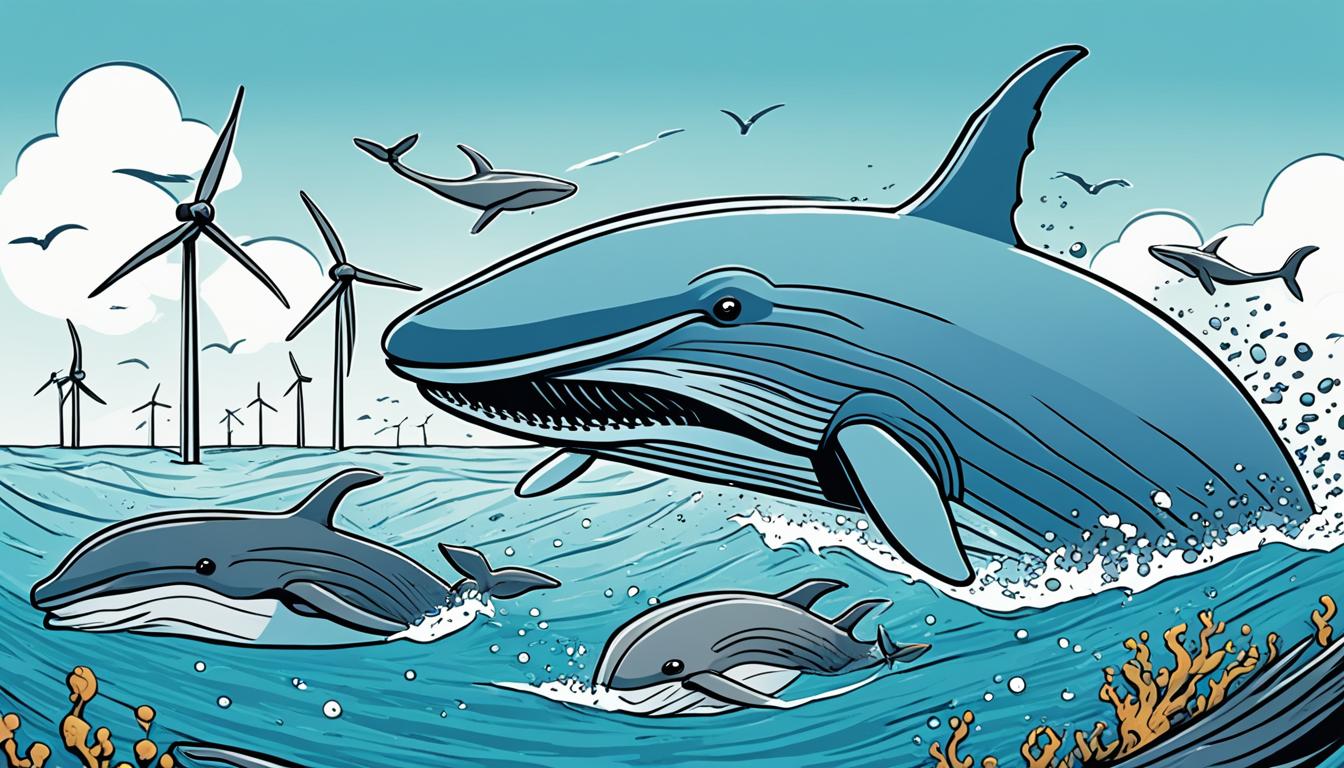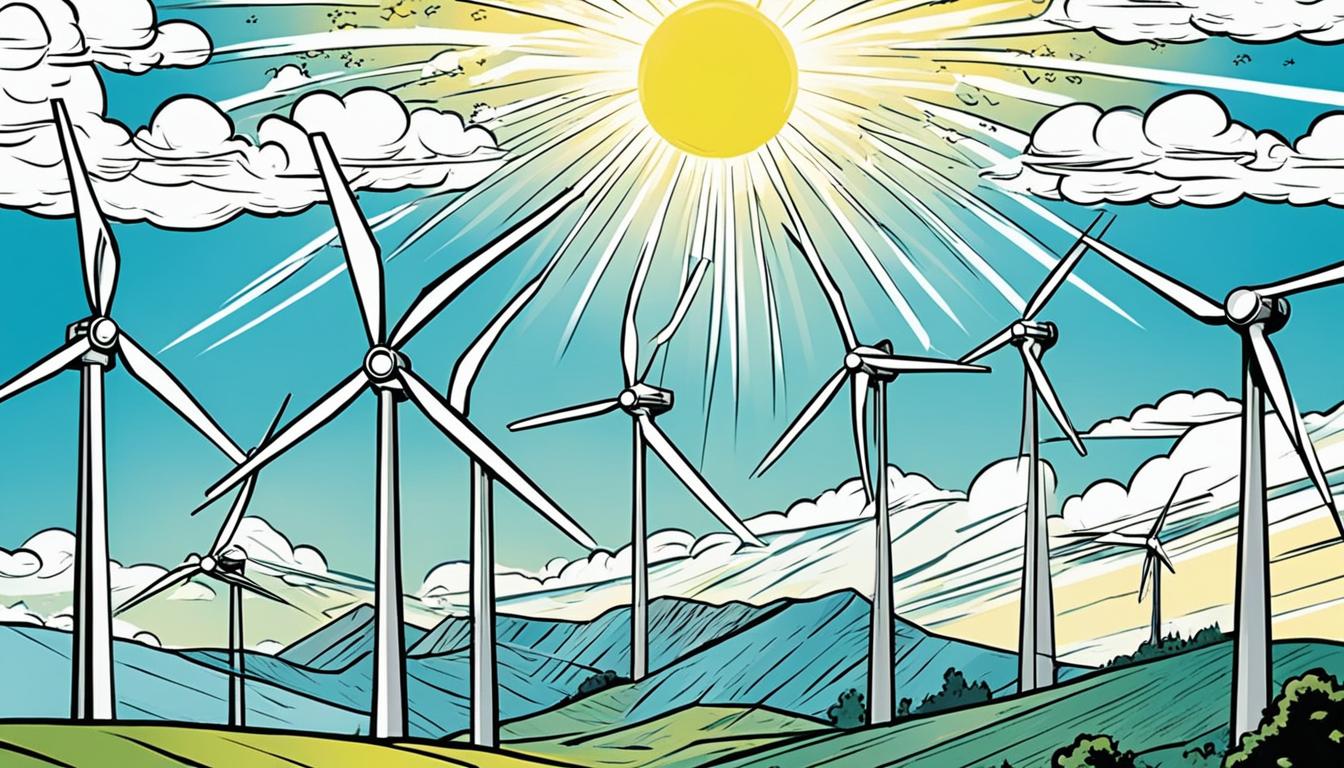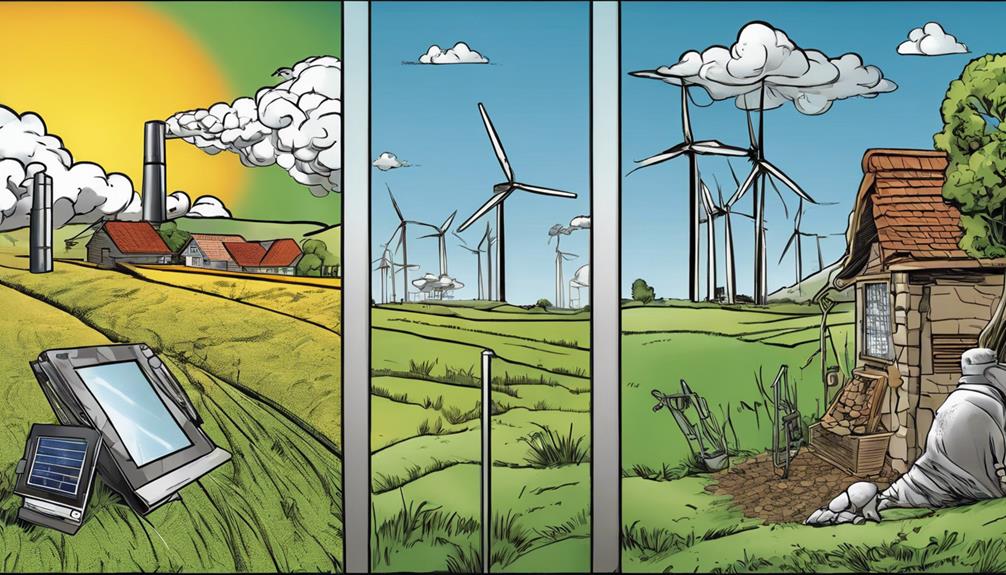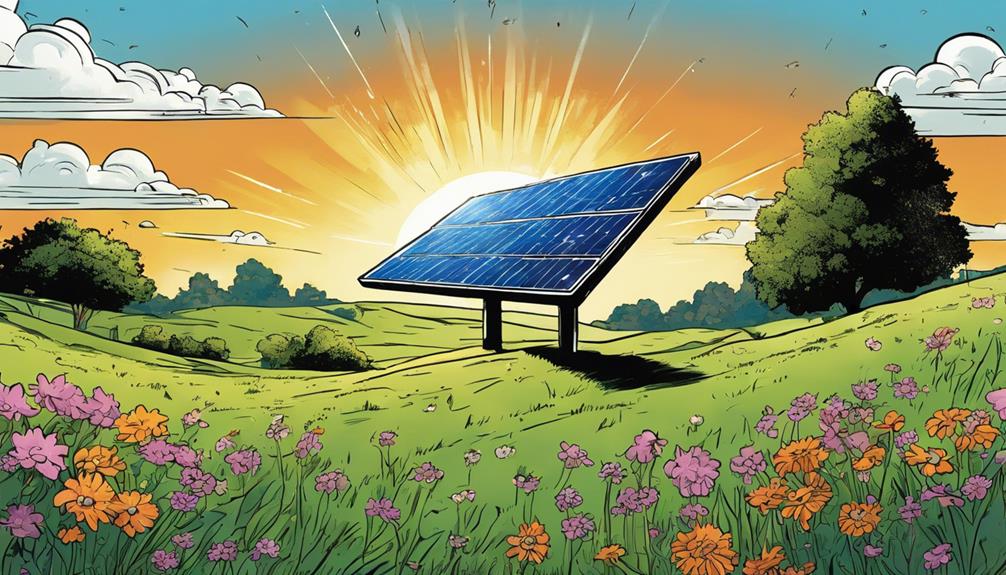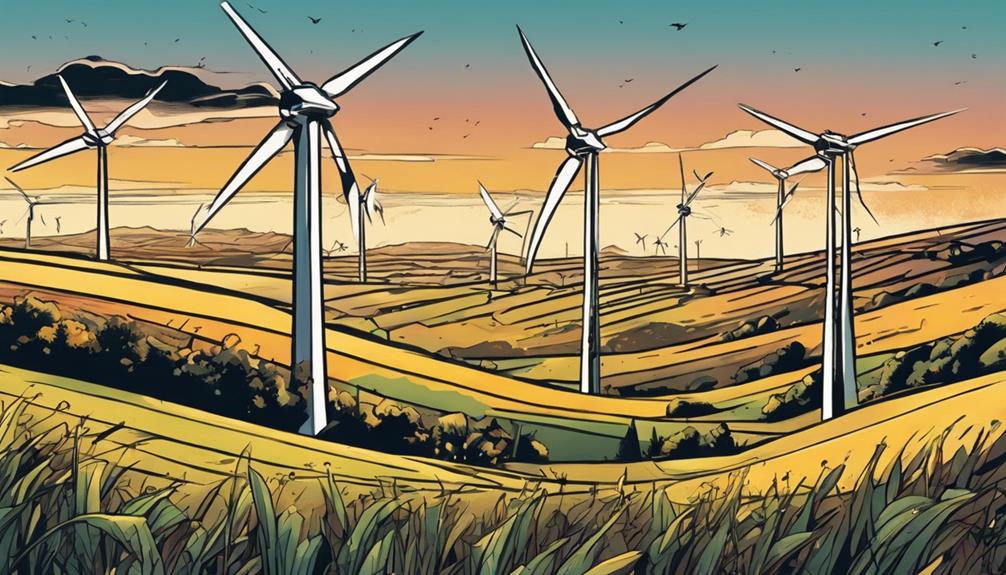Did you know no science proves that whale deaths are caused by noise from wind turbines at sea? Despite what some people say, ongoing offshore wind projects have not caused whale deaths1. The recent whale strandings on the East Coast are still under review. However, they have not been linked to wind turbines1. As people discuss how offshore wind farms might affect whales, it’s crucial to know the real facts from myths.
Key Takeaways:
- There is no scientific evidence linking offshore wind development to whale deaths1.
- Whale strandings on the East Coast are being investigated, but there are no known links to wind turbines1.
The Impact of Offshore Wind Development on Whales
People worry about offshore wind farms affecting whales. But, research says the noise from wind farm surveys doesn’t hurt whales much. This noise is less harmful than sounds from oil drills or military tools.
Offshore wind projects do make sounds but not like the loud ones from oil and gas explorations. The2operators also try to protect sea animals by getting special permissions.
While we’re concerned about whale deaths, other things like ship hits and fishing gear are bigger threats. These are what really endanger whales, not the wind farms.
The North Atlantic right whales are really struggling. Between 2011 and 2020, we lost 43% of them. Experts think they might not survive the next 30 years234. Hunting long ago made their numbers drop. But they were making a comeback, reaching 483 whales in 201024. Now, sadly, there are only about 360 left24.
People worry about wind farms for several reasons. They think ships and gear for the farms might hurt whales24. But, we are trying hard to prevent this from happening.
Research at places like the South Fork Wind project shows whales don’t change much during construction noise2. And the noise from wind turbines isn’t usually loud enough to hear over natural ocean sounds2. This information helps us understand how wind farms affect whales.
It’s vital to listen to groups trying to protect whales. Some may have other motives4. However, through science and careful planning, we can protect whale populations well.
The Role of Climate Change in Whale Strandings
Ocean warming from climate change deeply affects marine life, including whales. Whales’ food sources are moving due to these warmer waters. This makes whales change their migration routes, causing more encounters with human activities like ships and fishing.
Climate change makes prey move, leading whales into danger5. Entering ship paths and fishing areas can end badly for them, with entanglements or hits by vessels6. Such dangers threaten their survival, especially for those like the North Atlantic right whale that are nearing extinction.
Climate change isn’t just about direct dangers. Warmer seas mean less food, which can make whales malnourished and sickly. Being weaker makes them more prone to diseases and other problems, pushing up death rates6.
Combating climate change is vital for marine life and our planet. Offshore wind farms are key in fighting climate change. They cut down on fossil fuels and reduce harmful gases6. By investing in clean energies like offshore wind, we support a healthier planet for whales and other sea creatures.
| Key Statistics | |
|---|---|
| Number of commercial offshore wind farms under construction in the United States | 2 |
| Number of homes in the US aimed to be powered by offshore wind by 2030 | 10 million |
| Percentage of recovered whale carcasses showing evidence of death from fishing gear entanglement or vessel strikes | 40% |
| Number of whales that have died off the East Coast since Dec. 1, 2022 | 83 |
| Rate at which humpback whales have been dying since 2016 | Advanced rate |
| Remaining population of North Atlantic right whales | Fewer than 360 |
| Federal law limits on human-generated sound underwater | Continuous noise and short sudden bursts |
| Ørsted restriction on driving piles to protect migrating whales | Between Dec. 1 and April 30 |
| Equinor limitation on pile driving to avoid whale presence | Months when right whales are least likely to be present |
| Impact of misinformation on opposing offshore wind projects involving harm to whales | Being extensively used |
| Request for an investigation into offshore wind industry impacts on commercial fishing and marine life | Requested by Republican congressmen |
| Suggestion that global warming has caused changes in whale habitats | Suggested by scientists |
Current Status of the Humpback Whale Population
The humpback whale population in the North Atlantic is not listed as threatened or endangered. Yet, they are protected under the Marine Mammal Protection Act. NOAA Fisheries keeps an eye on their numbers through regular stock assessments. Scientists are still figuring out why more humpback whales are dying recently.
Data from NOAA shows a distressing fact7. Over 500 humpback, minke, and right whales have been hurt, found ashore, or died too soon since 2017. This shows how much danger these beautiful animals are in.
To help humpback whales, there are limits on how fast boats can go. Since 2008, NOAA has made boats 65 feet or longer slow down to 10 knots7. Yet, even with these rules, 84% of boats didn’t slow down in certain areas from 2020 to 20227.
Warmer oceans are also causing problems for humpback whales. Now, about 40% of North Atlantic right whales spend their summers in the Gulf of St. Lawrence. This puts them at a higher risk of being hit by boats7. It’s clear we need stronger actions to keep these species safe.
Some wind energy projects are doing their part to reduce harm to marine life. For example, South Fork Wind promises to apply NOAA’s 10-knot speed limit to all its boats7. This shows that the wind energy sector is serious about protecting the ocean and its creatures.
California has set rules to keep the eastern Pacific gray whales safe during offshore wind projects. Boats doing survey work have to follow these speed limits7. Such steps are vital for protecting whale travel paths and avoiding accidents.
Additionally, these projects have experts looking out for marine animals. These Protected Species Observers use special cameras when it’s hard to see7. With these experts and tools, they can spot and avoid harming marine life.
When installing wind turbines at sea, the noise can bother whales. But they use bubble screens and avoid noisy construction near marine animals7. This helps keep the ocean quiet and safe for whales with sensitive hearing.
It’s worth noting, seismic surveys for oil are much louder than for wind energy. But there’s no proof the louder surveys have killed animals7. This shows offshore wind is less disruptive to marine life.
Studies have found some non-profits against wind energy might have ties to big oil donors7. It’s a complicated issue, mixing conservation with politics. This makes the debate over wind energy’s effect on whales even more heated.
Statistical Overview
Here’s a quick look at some numbers about humpback whales:
– Since 2017, over 500 humpback, minke, and right whales have been in trouble near the East Coast7.
– NOAA’s 10-knot limit for larger boats has been ignored by 84% of them in slow zones from 2020 to 20227.
– Warm oceans have pushed 40% of North Atlantic right whales to summer in the Gulf of St. Lawrence, raising their accident risks7.
| Statistics | Source |
|---|---|
| More than 500 humpback, minke, and right whales have been seriously injured, stranded onshore, or died prematurely on or near the East Coast since 2017 | NOAA7 |
| NOAA has tried to enforce a 10-knot speed limit for vessels 65 feet or longer since 2008, with 84% of vessels still exceeding this limit in designated slowdown regions between 2020 and 2022 | NOAA7 |
| About 40% of North Atlantic right whales are now spending their summers in the Gulf of St. Lawrence due to rising ocean temperatures, increasing their risk of vessel strikes | NOAA7 |
Protecting Whales and Reporting Sightings
If you see a dead or injured marine mammal, it’s crucial to report it to the NOAA Greater Atlantic Marine Mammal and Sea Turtle Stranding Hotline8. It’s against the law to touch, feed, or harm marine mammals. Boat owners should use the Whale Alert app for updates on whale sightings and safe areas.
Slowing your boat and watching for whales helps avoid accidents with them.

Reporting Sightings to Protect Whales
Everyone needs to work together to protect whales and their homes. A key part of this effort is to report whale sightings. This helps collect important information for research and to save these great animals8.
When you report whale sightings, you help us learn about their numbers, where they travel, and the dangers they might face. This info is important for making plans to keep them safe.
If you spot a whale, it’s important to give clear details like the type of whale, where it was, and what it was doing. This helps scientists track whales, find out where they like to be, and keep an eye on their numbers8.
In recent times, more whales are getting stranded, tangled, or hit by ships. These sad events are bad not just for whales but for the whole ocean. By telling us about whale sightings and other important info, you’re helping to stop these things from happening8910.
Whale Conservation Efforts
The number of whales is getting lower, and they face more dangers than ever. This situation has led to many efforts to save them. We aim to protect whales, the places they live, and the balance of life in the seas.
| Conservation Efforts | Impact |
|---|---|
| Establishment of Marine Protected Areas (MPAs) | MPAs create safe places for whales. They protect where whales travel, eat, and have their babies. |
| Adoption of Vessel Speed Limits | Lower speed limits for boats in whale areas reduce accidents and help whales behave naturally. |
| Development of Whale-Watching Guidelines | These rules teach people how to watch whales without bothering or hurting them. |
| Research and Monitoring Programs | Scientists gather information through research and tracking. They study whale behavior and how different dangers affect them. |
These efforts, with help from people, groups, and industries, can rebuild whale numbers for the future. By reporting whale sightings and supporting these plans, we can have a big effect on saving whales and ocean life.
Let’s all promise to keep whales safe. This way, they will continue to amaze us in our waters for a long time.
Debunking Claims Against Offshore Wind Turbines
Some people say offshore wind turbines kill whales, but there’s no strong proof11. Blaming wind turbines might take our attention from real threats to whales, like ships hitting them or getting caught in fishing gear.
The NOAA has been looking into whale strandings on the US east coast. Since 2016, 208 humpback whales have stranded, with 33 in 2023 alone11. But there’s no solid proof connecting these events to wind turbines11. Even before wind turbines were around, whales were stranding. For example, South Carolina saw seven humpback whale strandings since 199311.
About 90 humpback whales examined after death since 2016 showed that 40% died because of humans, like getting tangled in fishing nets or hit by ships11. This info shows whale deaths come from several causes, not just one thing.
Interestingly, the UK has the world’s biggest wind farms but hasn’t had humpback whale strandings connected to them11. This could mean the effects of wind turbines on whales might change in different places.
The NOAA hasn’t found any link between whale deaths and wind turbine surveys11. Although wind farms make noise, there’s not enough evidence to say they’re a big reason for whale deaths11.
It’s vital to challenge false claims about wind turbines harming whales. We must look at all possible reasons for whale deaths, like getting caught in nets, boat accidents, and environmental issues11.
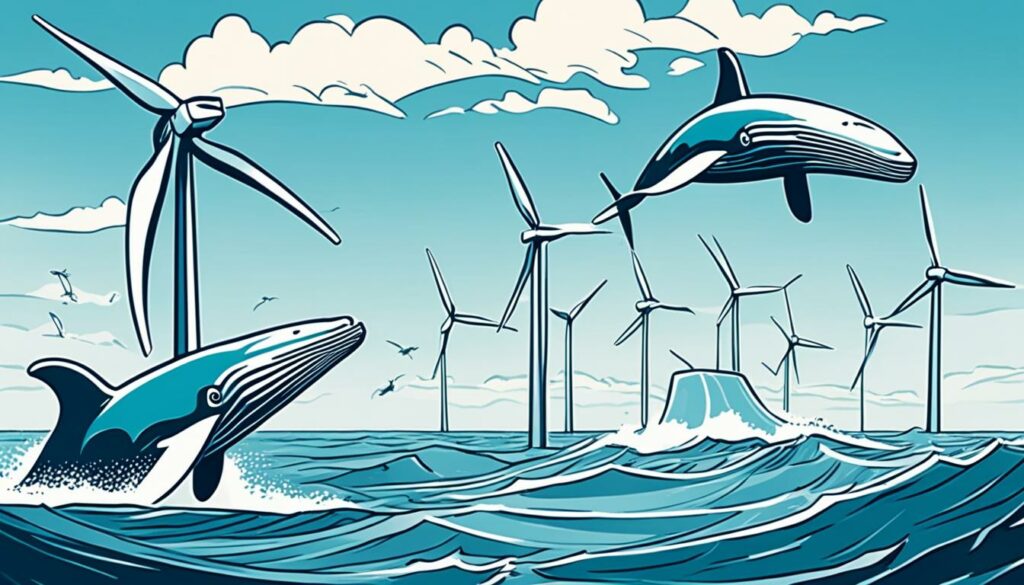
Comparison of Claims and Reality Regarding Offshore Wind Turbines and Whale Deaths
| Claim | Reality |
|---|---|
| A fake article claimed that offshore wind projects in the Illawarra and Hunter regions would kill 400 whales a year | This claim has been debunked by scientists12. |
| The alleged University of Tasmania study estimating future offshore wind projects could kill up to 400 whales per year | This study does not exist13. |
| Claims linking wind turbines to whale deaths | Marine scientists widely disagree with these claims13. |
| Whale deaths are primarily caused by wind turbines | Most whale deaths are attributed to other factors such as entanglement in fishing nets or vessel strikes1113. |
When talking about offshore wind turbines and whales, we need to trust science and facts. By clearing up myths and focusing on actual dangers to whales, we help protect them. This also supports green energy sources like offshore wind turbines.
Real Dangers Faced by Whales
Whales are amazing creatures living in our oceans. They face many dangers in their underwater world. It’s crucial for us to understand and tackle these issues. This allows us to protect and conserve whale populations. Let’s look into the real dangers whales face for their survival.
Ship Collisions and Fishing Gear Entanglement
Collisions with ships and getting caught in fishing gear are huge dangers. Statistics14 show that many whale deaths are due to these reasons. Research on humpback whales over four years found 40% died from ship strikes or gear entanglement.
Underwater Noise Pollution
Underwater noise pollution is another big problem. Activities like shipping and construction can disrupt whale communication and feeding. While data15 doesn’t directly link wind farms to whale deaths, scientists are watching for any impacts. These include changes in behavior and migration.
Threats to Specific Whale Species
Some whales are in urgent danger of extinction. For example, less than 360 North Atlantic right whales are left. Data15 underlines the need for action. We must save these whales from disappearing.
Comparing Wind Farms and Other Threats
Despite what some believe, wind farms haven’t been proven to kill whales in Europe or the US. Greenpeace has criticized the focus on wind turbines. High stranding rates and long-standing offshore wind projects show other dangers are more pressing for whales.
Taking Action for Whale Conservation
To truly protect whales, we must tackle these dangers. Implementing safe shipping practices helps. So does promoting whale-friendly fishing gear and cutting down noise pollution. Studying wind farms’ effects on whales is also key for their future.
| Threats to Whales | Statistical Data |
|---|---|
| Ship Collisions and Fishing Gear Entanglement | 40% of humpback whale deaths investigated in the past four years showed evidence of being killed by ship strikes or entanglement with fishing gear14 |
| Underwater Noise Pollution | US scientists are monitoring possible impacts of wind farms on whales such as altered behavior or changes to migration routes14 |
| Threats to Specific Whale Species | Less than 350 North Atlantic right whales remain14 and15 |
| Wind Farms and Whale Deaths | Wind farms have not been found to cause whale deaths in Europe14 and wind farms are not directly linked to any whale deaths in the US15 |
Addressing these dangers leads us toward a future where whales prosper in their natural habitats. This ensures the balance of our oceans.

The Role of Renewable Energy in Protecting Whales
Renewable energy like offshore wind is key to fighting climate change. It also safeguards whale populations and their living areas. By cutting down on greenhouse gases and moving away from fossil fuels, we protect whales. This helps keep their habitats stable and their food supply unchanged.
The federal government aims to build 30 gigawatts of offshore wind energy by 203016. This goal could create 77,000 jobs and power 10 million homes. It would also cut carbon emissions by 78 million metric tons16.
North Atlantic right whales are one of the most at-risk whale species. They live on the east coast of the US and Canada16. Growing renewable energy offshore protects these whales by reducing habitat disturbances.
Monitoring whales is crucial for saving them. Saildrone’s vehicles have traveled nearly 1,000,000 nautical miles for this purpose16. These drones make studying marine mammals cheaper and less harmful to the environment16.
Some worry offshore wind farms could harm marine life. Yet, NOAA Fisheries found no proof that noise from wind surveys harms whales1. Wind developers do detailed surveys to ensure they disturb marine life as little as possible1.
Climate change is bad news for whales. It messes with where marine animals live and makes whales come closer to shore1. Using renewable energy helps us fight climate change. This protects the homes and food whales need to survive.
Humpback whales in the North Atlantic are not endangered but still have protections1. The Marine Mammal Protection Act safeguards these whales. It sets rules to prevent harm from human activities1.
Studying dead whales helps us understand why they die. NOAA Fisheries and partners perform these studies, which are tricky due to decay1.
Recently, humpback and sperm whales washed up dead in New Jersey and New York17. In a few months, nine whales were found. About 40% had injuries from ships or entanglement17. This shows the dangers whales face and the importance of protecting them.
We need to reduce human threats to whales and support clean energy. By backing renewable energy, we can keep the ocean healthy. This will protect whales and other marine life for the future.

Table: Active Authorizations for “Level B” Harassment and Non-Serious Injury From Noise Exposure
| Activity | Number of Authorizations |
|---|---|
| “Level B” Harassment from Offshore Wind Sites | 12 |
| Noise Exposure During Pile Driving Activities | 2 |
Source: Statistical data from link 317
Conservation Efforts and Research
Scientists and groups dedicated to conservation are working non-stop. They aim to protect whales by studying why they die and how to save them. By figuring out what causes their deaths, they can make plans to keep them safe.
Research is focusing on how people’s actions affect whales, like when ships hit them. On the East Coast, lots of whales have been dying for seven years. Unusual Mortality Events were announced for several whale species between 2016 and 201718. With ships moving more in the last five years, whales are at bigger risk of being hit18. Over 15 North Atlantic right whales have been hurt or killed by ships near New York between 2017 and 202318.
Scientists are looking into how whales behave and where they go. In one area, many whales were seen more than once from 2011 to 2018. This shows they stay around for about a month on average18. These discoveries show why it’s crucial to keep their homes safe and undisturbed.
New technology is being created to watch and track whales better. In 2021, a big research project started thanks to a grant from Ørsted to the Woods Hole Oceanographic Institution18. Their goal is to better detect North Atlantic right whales using sound buoys.
Studies in New York’s waters have seen more whales lately, thanks to groups like Gotham Whale18. This is good news and shows why we must keep working hard to protect them.
It’s very important to keep an eye on whales and figure out why they die through necropsies. About 40% of large whale strandings had signs of being hit by ships or getting tangled in ropes19. This information helps us understand how humans affect whales and plan better ways to protect them.

Groups are joining forces to keep whale homes safe. They work on making rules and teaching people who boat and fish about the dangers whales face. Their goal is to lessen the chances of whales getting hit by boats or caught in things.
To sum up, it’s key to keep studying and working to save whales. With good research and everyone working together, we can make sure whales are around for a long time.
Conclusion
After studying the data, we see that wind turbines in the ocean aren’t killing whales20. NOAA Fisheries and other sources found no connection between wind development and whale deaths20. The true causes are ship strikes and fishing gear entanglement21. We need to tackle these to save marine mammals.
Projects like Ocean Wind I and Orsted’s Ocean Wind II are key for clean energy20. Ocean Wind I will have 98 turbines near Atlantic City. It’ll power about 500,000 homes a year20. Ocean Wind II and Atlantic Shores will power even more homes20.
Over 5,000 offshore turbines have been built globally without harming whales21. These turbines produce less noise than ships, which harm whales more21. They benefit marine life by creating fish habitats and protecting whales from ship noises21.
We must know the facts and not spread misinformation about wind farms and whales22. By choosing renewable energy and fighting real dangers like ship hits, we can save whales. This also fights climate change for a better future22.
